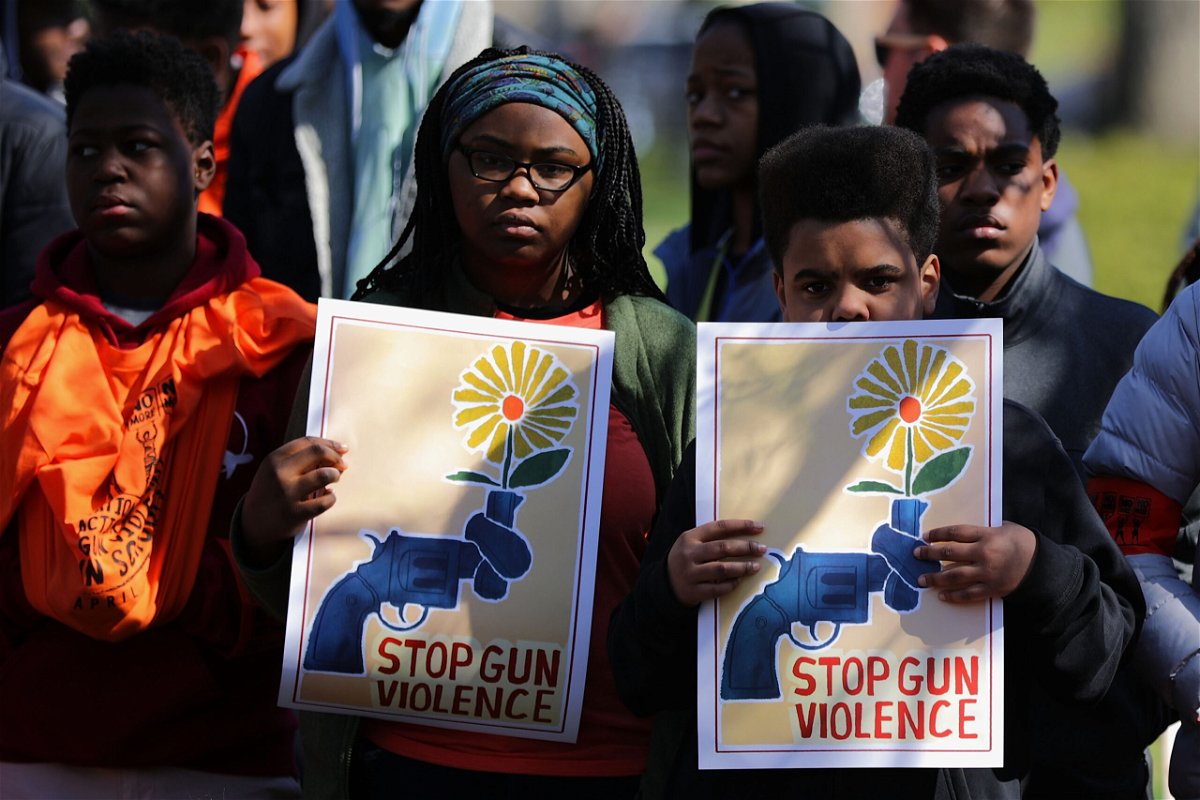About 1 in 5 high school students have witnessed community violence, new CDC report says

High school students from the Washington area rally in front of the White House before marching to the U.S. Capitol to call for stricter gun laws on April 20
By Jacqueline Howard, CNN
About 1 in 5 high school students in the United States has seen violence first-hand among people who are not related, including homicides involving guns. That’s according to a new report from the US Centers for Disease Control and Prevention, which calls community violence “a significant public health concern.”
In 2021, the most recent year for which data were available, 19.9% of high school students reported ever witnessing community violence and 3.5% reported carrying a gun during the past year, according to the CDC’s biennial Youth Risk Behavior Surveillance reports, released Thursday. The data also showed that students who witnessed community violence were more likely to report carrying a gun, engaging in substance use and considering or attempting suicide.
Overall, according to the report, suicide is the third leading cause of death among 14- to 18-year-olds.
“Previous research has demonstrated that young persons might carry weapons for self-defense to protect against future violence, particularly when they have been directly victimized or perceive high levels of community violence,” CDC researchers wrote in the new report. “Community violence and gun carrying are significant concerns for youths in the United States.”
The researchers found that 29.3% of Black and 26% of American Indian, Alaska Native or Native Hawaiian students reported witnessing community violence compared with 24.5% of White, 21.3% of Hispanic or Latino, 14.8% of multiracial and 9.3% of Asian students.
Among lesbian, gay, or bisexual students, 27% reported witnessing community violence compared with 18.2% of their heterosexual peers, the researchers found.
In 2021, a total of 8.5% of students reported experiencing physical violence in their dating lives, 9.7% reported sexual violence related to dating, 11% reported sexual violence by anyone, the researchers found. And having experienced forced sexual intercourse in their lifetime was reported by 8.5% of all students.
The researchers also examined that 22% of students have reported being bullied in the past year.
The findings indicate that “multiple forms” of teen dating violence, sexual violence and bullying are “common experiences” for US high schoolers, the researchers wrote, and “violence victimization among youths is a public health concern.”
The report also showed that “substance use was common” among US high schoolers in 2021.
Approximately one-third of students, 30%, reported current use of alcohol or marijuana or prescription opioid misuse.
Among those current users, alcohol at 22.7% and marijuana at 15.8% were the most commonly reported substances, and 12.2% reported having misused prescription opioids in their lifetime. Overall, in 2021, 36.2% of students reported ever using electronic vapor products, the data showed.
Connections to others
The majority of US high school students — 61.5% — reported that they felt connected to others at school. Prevalence of feeling connected to others at school was highest among male students, at 65.5%, Asians at 66.7%, 9th- and 10th-graders at 63.3.%, and heterosexual students at 65.1%, the data showed.
The lowest prevalence of feeling connected to others at school was reported among students who were female at 57.6%, American Indian or Alaska Native at 53.9% or Black at 53.9%, and students who had questioning or other sexual identities at 48.3%.
“This report provides the first national prevalence estimates of school connectedness among U.S. high school students stratified by sex, race and ethnicity, grade, and sexual identity and examines the associations between school connectedness and a range of youth risk behaviors and experiences,” the researchers wrote.
The researchers also found that overall, 13.6% of students did not report that their parents or other adults in their family know where they are going all or most of the time, or with whom they will be.
“Reports of high parental monitoring were protective for all risk behaviors and experiences,” the researchers wrote.
Additionally, in 2021, nearly half — 47.1% — of students had eaten fruit or drunk 100% fruit juices less than once a day, 45.3% had eaten vegetables less than one time a day and 75% had not eaten breakfast daily, according to the report.
In 2021, fewer than a quarter — 23.9% — of students had been physically active for at least 60 minutes a day on all seven days of the week, and 44.9% had exercised to strengthen or tone their muscles at least three days a week.
“Although healthy dietary and physical activity behaviors are important for adolescents’ overall physical health, this study found that none of the 11 behaviors examined in this report have improved since 2019,” the researchers wrote.
The-CNN-Wire
™ & © 2023 Cable News Network, Inc., a Warner Bros. Discovery Company. All rights reserved.



